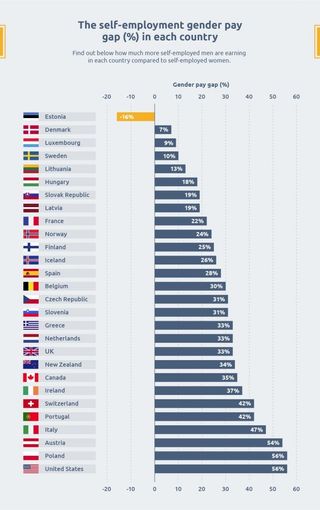The latest analysis of OECD (Organisation for Economic Co-operation and Development; made up of mostly rich countries) data by Appjobs proves the worst — the gender pay gap that is increasingly prompting women to join the gig economy is actually worse for freelancers. “The gender pay gap between self-employed men and women is far larger than the gap between men and women that are employees,” the report says.
Estonia is the only country where self-employed women earn more than men — by 16%, whilst the pay gap in the U.K. remains much larger at 33% and the U.S. at 56% (also the highest pay gap).
Source: AppJobs
Among self-employed persons too, women entrepreneurs attract less funding than men, and suffer from a general lack of support from investors, according to a 2017 OECD report.
A report released by the Observer Research Foundation in February 2019 pegged women’s participation rate in the Indian labor force at 27%, (though it might be way lesser by other estimates) against men’s participation rate of 96%, owing to patriarchal norms that hinder women’s agency, mobility, and freedom. “Rewriting the Rules: Women and Work in India” went on to suggest that as India hurtles towards a gig economy, the culture of companies contracting freelancers for independent projects is a crucial way to include more women, since it offers advantages such as easier and cheaper access, lower transaction costs, flexibility, and reduced barriers to entry.
Women know this; the number of women turning to self-employment has risen by 57% since 2008, and the number of women who freelance rose by 63%, a recent report by IPSE (the Association of Independent Professionals and the Self-Employed) found. That is more than double the increase in self-employed men in the same period, with two of the most common reasons for the change being better income (23%) and better work conditions (24%).
Related on The Swaddle:
All the Arguments You Need: To Convince People Who Think the Gender Pay Gap Isn’t a Thing
However, while the AppJobs report does not include findings for the gender pay gap amongst Indian freelancers and self-employed persons (as India is not a permanent member of the OECD), a 2017 report by Flexing It, titled “India’s Top-Tier Freelancers: What They Earn” suggests female freelancers with over 16 years of experience in their industry, earn 45-50% less than their male counterparts, on an average.
The reasons for this stubborn pay gap include women’s tendency to negotiate their rates lesser and settle for lower remuneration more easily than men, thanks to a society that has taught them to undervalue themselves. Another reason is the notion that women are not as flexible as men. “I believe my women counterparts sometimes lose out not in how they negotiate but how they develop business. Business development, at times, requires a level of flexibility, for example, meetings over weekends or late evening calls. There is a perception that women freelancers may be a lot less accommodating when it comes to such tasks, which might impact how they get paid,” Sunaman Sood, an independent consultant for over a decade, told LiveMint.
“Where there are no group-level protections, it is hard to [be] sure that people are not discriminating in what they pay people of different genders,” Sarah Kaplan, director of the Institute for Gender and the Economy at Rotman School of Management, Toronto, told Financial Times. She suggests pay transparency as a solution — making the average fees for services in various industries public, via the government or industry associations. “People would know if they are charging an adequate amount or being paid an adequate amount” — although she acknowledges this is “uncharted territory.”





